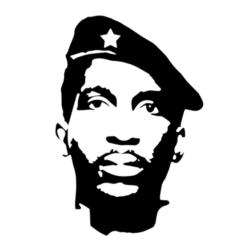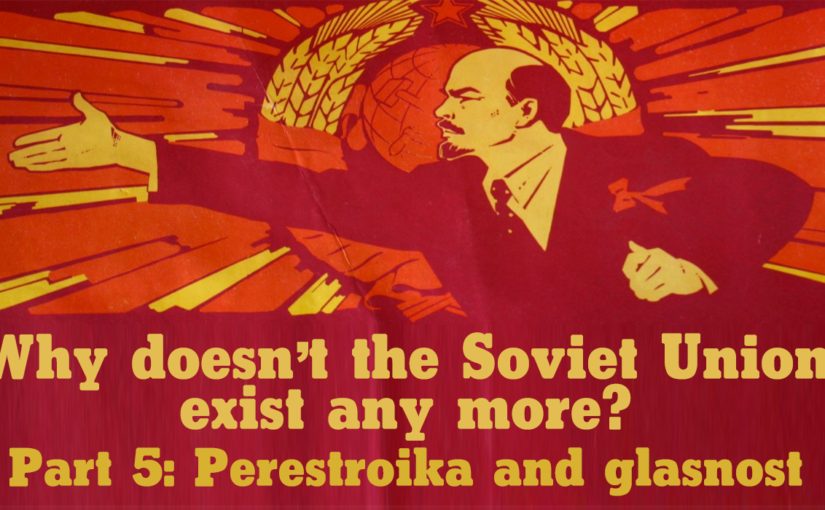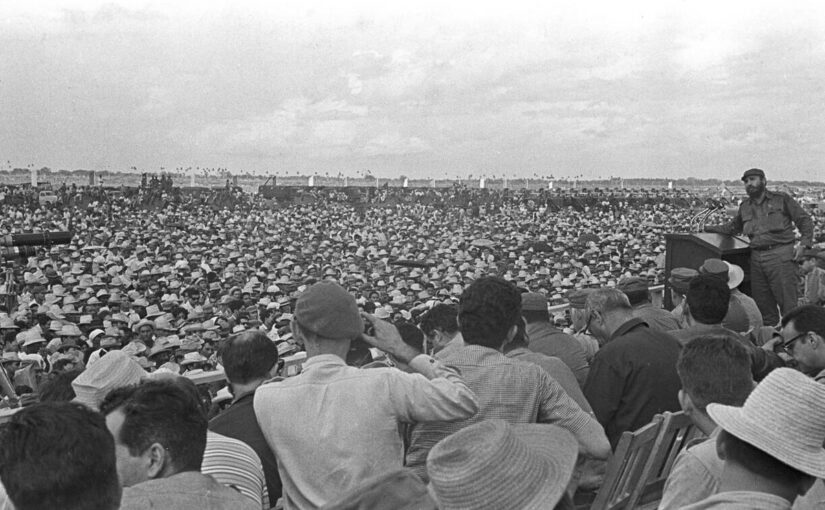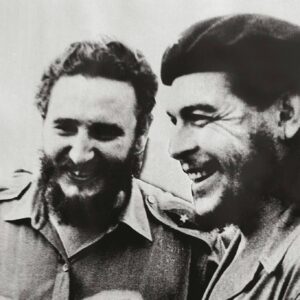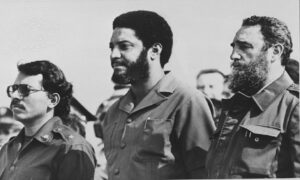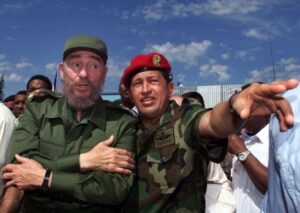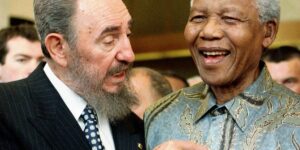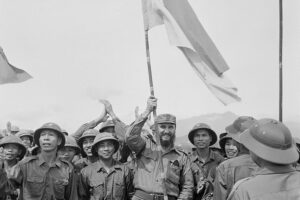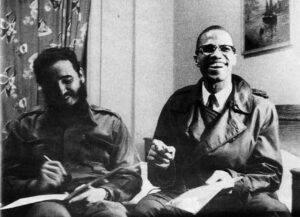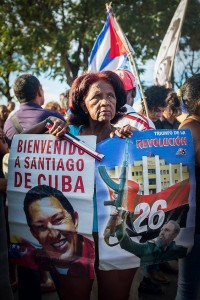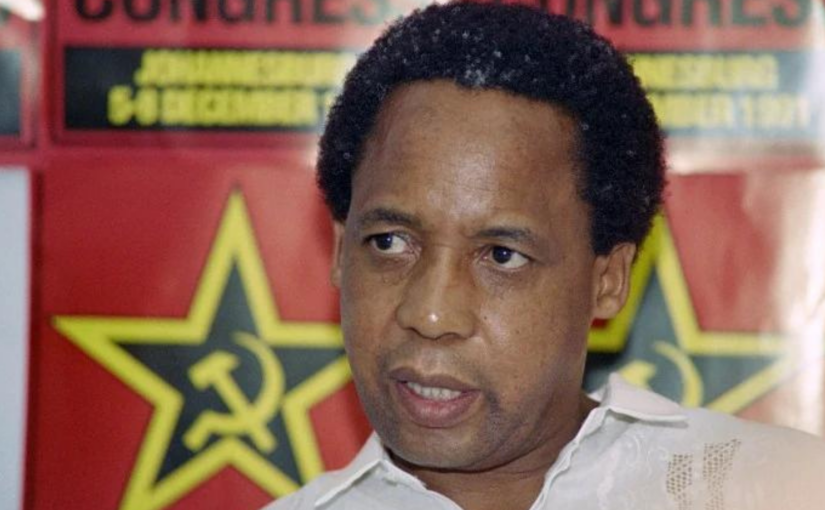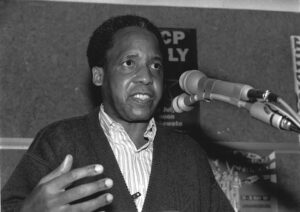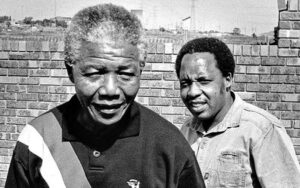We do not forget for a moment that we have committed and are committing numerous mistakes and are suffering numerous reverses. How can reverses and mistakes be avoided in a matter so new in the history of the world as the building of an unprecedented type of state edifice! We shall work steadfastly to set our reverses and mistakes right and to improve our practical application of Soviet principles, which is still very, very far from being perfect. (Lenin)1
As discussed in the previous article, the Soviet Union recorded world-historic achievements in many fields. Nonetheless, there were a wide variety of problems, limitations, weaknesses and failures to go with the victories and successes. Building the first socialist state in a world still dominated by aggressive, expansionist capitalism was a near-impossible task, analogous to a small child learning to walk while people stand nearby trying to push her over.
In this second article on the Soviet collapse, I will explore the history of the Soviet economic system, with a particular focus on the difficulties that emerged in the mid-1970s and the contribution of these problems to a decaying popular confidence in socialism as a system of production relations.
Economic performance up until the 1970s
Analysis of the available data indicates that, up until around 1975, the Soviet economy was working very well. Even Henry Kissinger was moved to declare in 1960 that, “starting from a position of substantial inferiority in almost all areas, the Soviet Union has caught up with and surpassed us in more categories than are comforting.”2
Economics professor Philip Hanson – by no means an ideological supporter of the Soviet Union – writes:
Well into the 1970s the Soviet Union was seldom described as failing. Its economy tended, up to the early 1970s, to grow faster than that of the United States. For a generation or more after the Second World War, the traditional Soviet aim of ‘catching up and overtaking’ the West was not patent nonsense… In the course of thirty years, from the end of the Second World War, the Soviet Union had recovered from wartime devastation and massive loss of life. It had made remarkable strides in military technology. It had broken the US monopolies of, successively, the atomic bomb, the hydrogen bomb and inter-continental ballistic missiles… And the lives of Soviet citizens had at the same time improved immensely.3
This was also a period of growth for the major capitalist economies, but the Soviet growth rate was significantly higher. Keeran and Kenny note that “between 1950 and 1975, the Soviet industrial production index increased 9.85 times (according to Soviet figures) or 6.77 times (according to CIA figures), while the US industrial production index increased 2.62 times”.4 In fact, “from 1928 to 1970, the USSR was the fastest growing economy except for Japan”.5 What’s more, the Soviet economy was not susceptible to the cycle of boom and bust that plagues capitalist economies.
Economic success was not manifested purely in terms of growth figures or scientific achievement; it was reflected in a steadily improving quality of life for ordinary people. After a period of extraordinary upheaval – World War I, the Revolution, the war of intervention, rapid industrialisation and agricultural collectivisation, and then World War II (in which the Soviet Union lost an estimated 27 million people) – the period from the mid-1940s to the mid-1970s was one of steady rebuilding, in a relatively peaceful external environment. For example, “in 1960 about one out of two Soviet families owned a radio, one out of ten a television, and one out of twenty-five a refrigerator. By 1985 there was an average of one of each per family.”6 Everybody had work – a vastly important quality-of-life indicator – and the quality of state-provided services such as education and healthcare continued to improve.
The key to early economic success: socialist planning
These successes were not built on the base of any deep-rooted strength in the pre-revolutionary Russian economy; Russia before October was in fact “in terms of every economic index among the most backward and poorest of European countries. Its per capita income in 1913 was about 102 roubles, compared to that of England, 463 roubles, France, 355, and Germany, 292.”7 The industrial working class constituted just 2 percent of the population. Following World War I and the war of intervention, the economy was utterly decimated.
In a resolution discussing the then-recent collapse of the USSR, the 14th Congress of the Communist Party of India (Marxist) described the extraordinary obstacles over which the Soviet people had to climb in order to modernise:
The relatively low level of productive forces and the associated backward production and social relations had to be substantially raised, and at a breakneck speed, bypassing the stage of capitalism, to levels that could sustain socialist construction. This had to be done relying purely on internal resources, without access to the higher techniques of production developed by capitalism and in an hostile international atmosphere when world capitalism tried all methods at its disposal to asphyxiate socialism. It is in fact a testimony to the superiority of the socialist system that such a gigantic task could be achieved.8
What drove Soviet economic success, allowing it to emerge from the chaos of war, quickly industrialise, develop to the level of being able to defeat the Nazi war machine, and establish a standard of living comparable to middle-income European countries was, first and foremost, the system of central planning set in motion in 1928 with the first five-year plan. Although this assertion flies in the face of established economic wisdom that “planned economies don’t work”, the facts are beyond dispute.
Kotz and Weir explain that the system of central planning “achieved a very high rate of investment, which made possible the rapid creation of a whole set of new industries. It was able to rapidly educate and train the population for industrial work and rapidly shift the population into better-paying, more productive urban industrial jobs… The highly centralised planning system also proved effective at the process of building at least the first stages of a modern urban society, with a reasonably high level of amenities and consumer goods for the population… Soviet central planning proved able to rapidly build urban infrastructure (transportation, communication, power, etc), construct new housing, and manufacture new consumer goods.”
The Soviet economic system was particularly well suited to the tasks of rapid industrialisation and preparation for war. A predominantly rural, technologically backward, poorly educated country was transformed into a modern industrial economy with a high level of education; a world power capable of defeating the Nazi war machine. Almost exactly ten years before the Nazis launched their attack on the Soviet Union, Stalin famously summed up the essential challenge of the era: “We are fifty or a hundred years behind the advanced countries. We must make good this distance in ten years. Either we do it, or they crush us”.9 The first and second five-year plans enabled the Soviet people to rise to that challenge. It is unlikely that any other economic framework would have allowed such rapid development; no capitalist economic programme has brought about large-scale modernisation in so short a period of time.
To everyone’s surprise, the early Soviet industrialisation was a big success, most graphically proven by its ability to repel the Nazi advance on the Eastern Front during the Second World War. Income per capita is estimated to have grown at 5 per cent per year between 1928 and 1938 – an astonishingly rapid rate in a world in which income typically grew at 1-2 per cent per year.10
Growth starts to slow down
Soviet economic performance remained strong through the 50s and 60s: the postwar construction was another heroic effort and a victory for socialism. Living standards increased rapidly, and the growth rate remained higher than the US. However, this trend didn’t continue. “From 20 percent the size of the US economy in 1944, [the Soviet] economy peaked at 44 percent that of the US by 1970 ($1,352 billion to $3,082 billion) but had fallen back to 36 per cent of the US by 1989 ($2,037 billion to $5,704 billion).”11
Siteram Yechury, General Secretary of the Communist Party of India (Marxist), notes: “By the mid-1970s, the Soviet economy showed declining trends in growth rates. This is for the first time since the introduction of the five-year plan that such a trend becomes visible. During the decade 1976 to 1985 the growth rates of both the national product and industrial production declined. The plan targets were not achieved under the five-year plan of 1976-80 and 1981-85. In the earlier plan agricultural production grew at 1.16 per cent and the latter at 2.1 per cent, but both fell well short of the plan targets.”12
At a time when the geopolitical environment was starting to look relatively stable and promising – with the victory of the popular forces in Vietnam, Angola, Mozambique, Guinea Bissau, Ethiopia, Zimbabwe, Laos, Cambodia, Ghana, Nicaragua and Afghanistan, and with the apparent possibility of a lasting detente between the US and USSR – internal economic problems arose in the Soviet Union that started to develop a creeping intractability. The reasons for this are manifold and disputed, but they centre around a failure of the existing economic system to produce significant gains in productivity from the mid-1960s onwards.
Depleted resources
One great advantage the Soviet Union had in its socialist industrialisation was the availability of huge quantities of fossil fuels. These continued to play an important role in Soviet economic growth, and furthermore helped to make up for weaknesses in other areas: difficult climate and soil conditions meant that food production had always been a challenge, and the changing needs and expectations of the post-war population made this problem ever more prominent; however, exports of primary goods generated sufficient hard currency to import food to supplement domestic produce.
By the 1970s, resource extraction was getting harder and more expensive. Existing oil fields became less productive, and new ones had to be found. Hanson writes: “The depletion of oil, gas, coal and mineral resources in the European part of the USSR was forcing new natural-resource extraction to move east of the Urals – mainly to West Siberia. Extraction costs per unit of output were not necessarily higher in these new locations (though in some of them, in the far north, they were). However, these new regional developments required investment in transport, communications, housing and other infrastructure and the transport westwards of most of the energy and materials extracted, since the great bulk of manufacturing and urban settlement remained west of the Urals.”13
On top of this, the supply infrastructure was starting to suffer from inadequate investment. Kotz and Weir point out that “by the mid-1970s the Soviet rail system had reached the limit set by its rail miles, and congestion began to slow deliveries. The failure to make timely investments in expanded rail miles and new sidings had created a serious bottleneck for the Soviet economy.”14
Another important factor here is the tragic human loss from the war; horrific in its own right, it also had a knock-on effect on the postwar economy. Sam Marcy writes that “instead of having millions of excess worker-veterans returning, a whole layer of society, 20 million workers and peasants, had been torn away. A mighty economic force had thus been wiped out. These included men and women, both skilled and unskilled. Those who were killed were generally younger, which left an older population to tend to industry and agriculture. The USSR was deprived of a tremendous source of labour power, most particularly among the young on whom future generations generally rely. This set the USSR far behind the US, which had suffered no destruction at home and had lost 400,000 troops, or about one-fiftieth of the Soviet war dead. As soon as the war ended, the US was able to begin the production of consumer goods. These had been scarce during the war, but not nearly as scarce as in the USSR, which suffered the full-scale invasion of the Nazi armies.”15
The need to increase labour productivity
To win the victory in economic competition with capitalism it is necessary to surpass the advanced capitalist countries in the level of productivity of labour.16
A large portion of the early success of the planned economy was based on mobilising vast human and material resources for a single project. Actual labour productivity – the level of output per unit of human labour – remained relatively low compared to the advanced capitalist economies. Jonathan Aurthur explains in his 1977 book Socialism in the Soviet Union:
The reliance on extensive (more of the same labour and means of production) rather than intensive (new technology) was another reflection of the historical conditions in which socialism was being built. Capital was very limited, help from the advanced capitalist countries was even more limited, and within the country there was a very small supply of skilled labour to build and operate sophisticated machinery, even if the capital to build or import it had been available. At the beginning of the period of real industrialisation (1927) the industrial proletariat was very small and its skilled sector even smaller. Eleven million peasants with virtually no technical or any other kind of training became industrial workers during the period of the First Five Year Plan. Under these conditions heavy industry could be built only by relying on large expenditures of human labour in the construction of big, basic, non-specialised factories set up to produce tractors one day and tanks the next day or the day after…
Further, capital expenditure on heavy industry had to be rigidly centralised in order to conserve as much as possible. Priorities within the capital goods sector had to be made. Thus less was spent on transportation than on the construction of factories. This is why even today the Soviet Union is very poor in paved roads and trucks. There was never enough capital to build what was necessary for the expanding economy. To get around the transportation “bottleneck” Stalin built universal production centres, huge industrial complexes in which different kinds of production were centralised in one place near sources of minerals or other necessary raw materials. Factories were not created as specialised units producing a particular product; rather they were made to build many different products. A given factory might produce heavy, large-scale machinery, as well as high quality steel, sewing machines, agricultural equipment, precision tools, elevators, and bicycles.
It is a law of technology that the more types of jobs a tool can do, the less specialised and productive it will be. Stalin’s universal production centres were the best solution to the needs of industrialisation under the existing conditions. But they could not and did not lead to the development of a highly technical, capital intensive industry.17
It was clear by the 1970s, with increasingly limited scope for expanding the use of raw materials or labour, and with a relatively advanced and complex economy, that a qualitative leap in labour productivity was needed if the Soviet Union was going to continue to catch up with the west in terms of development and living standards. Such was recognised by, for example, Yuri Andropov – then a leading Politburo member and head of the KGB (and later the General Secretary of the CPSU from 1982 until his untimely death in early 1984) – who stated in 1970: “We have reached a stage where the factors of extensive economic growth have largely been exhausted, so that high rates of economic development and, consequently, of raising the material wellbeing of the Soviet people can be maintained mostly by intensifying social production.”18
There are some obvious methods of increasing productive output per unit of labour employed: one is to get workers to work harder and more effectively; one is to reorganise the system of production so as to make it more efficient; one is to invest heavily in infrastructure related to production; another (typically the most important) is to leverage technology so that more work is done by machines and less by humans. The Soviet leadership tried all these methods and ultimately found them all extremely difficult. Rather than bringing about the steady increase in labour productivity that was so desperately needed, what actually happened was that, “after 1975, industrial labour productivity growth fell drastically – by nearly 50 per cent according to official statistics and by two-thirds based on Western estimates”.19
The prevailing planning system was no longer fit for purpose
The central planning system implemented from 1928 was, as described above, hugely successful; however, an economic framework that was appropriate in 1928 wasn’t necessarily appropriate a quarter of a century later, in significantly changed circumstances. Indeed, in the post-war period, central planning came up against several increasingly stubborn problems.
Compared to the late 1920s, the Soviet economy of the 1950s was infinitely more complex and therefore more difficult to tightly plan. In the aftermath of the devastation of war and a widespread feeling that the Soviet people had earned an easier life in a context of ‘peaceful coexistence’ (of which more in the next article), there was some re-focussing towards the production of consumer goods, meaning a far greater range of items to produce. A linear increase in the number of goods to produce meant an exponential increase in the complexity of the plan, which became increasingly fragile. Keeran and Kenny, strong supporters of the planned economy, accept that “planning became more difficult as the economy became larger and more complex. By 1953, the number of industrial enterprises reached 200,000 and the number of planning targets reached 5,000, up from 300 in the early 1930s and 2,500 in 1940.”
Michael Parenti outlines the issues in his excellent book Blackshirts and Reds:
Central planning was useful and even necessary in the earlier period of siege socialism to produce steel, wheat and tanks in order to build an industrial base and withstand the Nazi onslaught. But it eventually hindered technological development and growth, and proved incapable of supplying a wide-enough range of consumer goods and services. No computerised system could be devised to accurately model a vast and intricate economy.
No system could gather and process the immense range of detailed information needed to make correct decisions about millions of production tasks. Top-down planning stifled initiative throughout the system. Stagnation was evident in the failure of the Soviet industrial establishment to apply the innovations of the scientific-technological revolution of the 1970s and 1980s, including the use of computer technology. Though the Soviets produced many of the world’s best mathematicians, physicists, and other scientists, little of their work found actual application.20
One important problem highlighted by Parenti is that, with the prevailing system of planning based on ambitious numeric quotas, enterprise managers had very little incentive to introduce new technologies. “They maintained their positions regardless of whether innovative technology was developed, as was true of their superiors and central planners.” Furthermore, the plan tended to encourage a mindset of quantity over quality: “Under pressure to get quantitative results, managers often cut corners on quality… For instance, since state buyers of meat paid attention to quantity rather than quality, collective farmers maximised profits by producing fattier animals. Consumers might not care to eat fatty meat but that was their problem. Only a foolish or saintly farmer would work harder to produce better quality meat for the privilege of getting paid less.”
Persuading people to work harder
One of the drivers of decreasing productivity was labour discipline; put simply, a lot of people were not working very hard.
Maintaining labour discipline in an economy with guaranteed full employment is challenging. Work – particularly tough, physical work – generally has to be incentivised in some way. Under capitalism, work is incentivised through fear of starvation: if you don’t do a decent job, you can easily be replaced from among the ‘reserve army of labour’. This a cornerstone of capitalist economics. In fact, the advances in productivity in the capitalist countries in recent decades have been in no small part based on ‘rationalisation’: replacing workers with robots, leaving low-wage, low-skill jobs for which there is ever-increasing competition (in a global labour marketplace with fewer and fewer borders).
The Soviet Union never had a problem with unemployment; on the contrary it suffered from overemployment – there were more jobs to do than there were people to do them. Consequently it rarely made sense for managers to sack people (and furthermore it was legally very difficult to do so). But if people know they are very unlikely to be sacked, it makes it easy for them to game the system if they are inclined to do so. Parenti writes: “If fired, an individual had a constitutional guarantee to another job and seldom had any difficulty finding one. The labour market was a seller’s market. Workers did not fear losing their jobs but managers feared losing their best workers and sometimes overpaid them to prevent them from leaving.”21
The issue of overemployment was more pronounced in the aftermath of the war, for the obvious reason that so many workers had been martyred, at a time when reconstruction of the country – and taking care of the sick and injured – demanded huge amounts of work.
Going on the experience of the first century of building socialism, it appears that in the early period of a revolution, it is typically easier to mobilise people to work well on the basis of moral incentives; on the basis of common sacrifice for a better future. Not to mention that a revolution is profoundly empowering: it unleashes the creative energy of the masses, which feeds into more and better production. But clearly it is extremely difficult to maintain this momentum over the course of multiple generations. Raúl Castro brought this issue to life in his description (in the late 1970s) of the spread and effect of labour discipline problems in Cuba:
The lack of work discipline, unjustified absences from work, deliberate go-slows so as not to surpass the norms – which are already low and poorly applied in practice – so that they won’t be changed … In contrast to capitalism, when people in the countryside worked an exhausting 12-hour workday and more, there are a good many instances today especially in agriculture, of people working no more than four or six hours… We know that in many cases heads of brigades and foremen make a deal with workers to meet the norm in half a day and then go off and work for the other half for some nearby small private farmer for extra income… or do two or three norms in a day and report them over other days on which they don’t go to work… All these ‘tricks of the trade’ in agriculture are also to be found in industry, transportation service, repair shops and many other places where there’s rampant buddyism, cases of ‘you do me a favour and I’ll do you one’ and pilfering on the side.22
As mentioned earlier, in the postwar period in the USSR, there was an emerging popular sentiment that, having sacrificed so much and having established a new level of geostrategic security through the emergence of friendly socialist governments in seven of twelve bordering countries, life should get easier and society should move towards fulfilling the socialist promise of mutual prosperity. For the leading capitalist powers, an easier life was established through exploitation of the poorer sections of the working class and through neocolonialism. For the Soviet Union, however, these options weren’t available. The way to have more food, better housing, better clothes, cars and so on was to produce more, to work harder.
The government of the time was keenly aware of the need to improve people’s immediate quality of life. Hanson writes that Nikita Khrushchev, in power from 1956 to 1964, “presided over a major switch of resources towards agriculture, improved incentives for food production, the launch of a badly needed housing programme, a shortening of the work week, a large cut in the armed forces and an easing of the priority for heavy industry… What all these improvements were not accompanied by was any serious reform of the economic system.” Hanson concludes that “the humane softening of the system that occurred under Khrushchev’s rule probably contributed to the later slowdown.”23
In addition to a reduced work week, the Khrushchev administration moved to reduce income inequality. Albert Syzmanski observed that, between the mid-1950s and 1970s, the Soviets “eliminated about half of the inequality in their income distribution (reducing the ratio of the highest decile’s to the lowest decile’s average wages from 8.1 to 4.1) – a radical reduction in inequality in a very short time”.24 During the same period in the US, there was practically no change in income equality. Although a more even wage distribution would have seemed more consistent with socialist ideals, the reduction of wage disparities also likely had the effect of reducing incentive to work and study.
Slowing innovation
From its first days, the Soviet government put a heavy emphasis on technical innovation as a means of modernising quickly and providing for people’s needs. Indeed, part of the promise of socialism is that it is a more advanced, more efficient path to development, freeing the realms of science and technology from the constraints imposed by profit, competition, endless intermediaries, exploitation and cyclical crises, and orienting them towards serving the people.
For over half a century, Soviet socialism largely lived up to this promise. In a few decades, Soviet science bridged the gap between the scientific backwardness of the old Russian empire and the heights of global progress. Great sacrifices were made in order to ensure scientific research received the level of investment it needed. A well-known Russian scientist, Boris Raushenbakh, complaining about the decline in research funding in post-Soviet Russia, remarked:
In 1918-19, Lenin organised a whole series of scientific institutes, including the Central Institute for Aviation and Hydrodynamics, the Leningrad Institute of Physics and Technology (which produced world-famous scholars Kurchatov, Kapitsa, and Semenov), and the Academy of Agriculture. These huge institutions were created at a time when … the entire country was consumed by the flames of civil war.
Under Stalin, a great number of institutes were created. In the mid-1930s, an independent Rockefeller commission, which had organised a philanthropic fund to finance science in poorly developed countries, visited our country. The commission’s report was published. Its conclusion: science was better financed here than in western Europe.25
In many key areas of science and technology, the USSR was able to catch up with the west, even becoming a global leader in some fields. However, by the mid-1970s the gap had stopped narrowing and then widened steadily until the collapse of the USSR. Computer technology was the most notable contributor to this yawning productivity gap. Computers and robotics were starting to penetrate all areas of the western capitalist economy, especially in the US. This led to significant gains in productivity; it dramatically increased the spread of information; and it fed into new developments in maths and other branches of knowledge. The Soviet Union, however, “largely failed to absorb the revolution in communication and information-processing brought by electronics and computers”.26 By the time of the Soviet collapse, use of computing in industry and military technology is reckoned to have been around 20 years behind the US.
It’s not immediately obvious why the Soviet Union would have lagged behind in the information revolution. Its education system – particularly in maths and science – was excellent; it invested heavily in research; scientists were among the best-respected (and best-paid) members of society; it was anxious to keep up with technological developments in the US; and its planning system stood to benefit massively from the improvements in statistics, logistics and information distribution offered by computerisation. While the working class in the capitalist countries has to a significant degree suffered from computerisation (through increased unemployment and reduced wages), the Soviet working class stood to enjoy unambiguous benefit.
Soviet government and academic circles certainly showed an early interest in computing and cybernetics, and considerable research went into this area. However, for a multitude of reasons, the gap between research and ground-level implementation was never bridged in the way it was in the US. At ground level, with a heavy emphasis on annual production targets, there was minimal incentive for risk-averse enterprise managers to introduce sweeping technological changes, and in the absence of a centrally-mandated and society-wide information revolution, computerisation was somewhat marginalised. This was recognised by some of the more economically-literate leaders, for example Andropov: “To introduce a new process or new technology, production should be reorganised one way or the other, and this affects the fulfilment of the plan. Moreover, one will be held responsible for failure to fulfil the plan, while all one will get for inadequate application of new technology will be just reproach…. It is necessary to see to it that those who boldly introduce new technology will not find themselves at a disadvantage”.27 No suitable means were found to resolve this problem. On top of this disincentive, there was a lack of resources to support those enterprise managers that were keen to innovate. Longstanding leader of the Communist Party of the Russian Federation, Gennady Zyuganov, writes: “Without access to financial resources, industrial enterprises could not update their equipment, introduce new technologies, or take advantage of the most recent achievements in science and engineering. The scientific establishment itself, except for the defence branches, lost the stimulus for development that should have been provided by demand for new projects and technical innovations.”28
Apart from the direct economic advantages, the spread of computing proved to be a powerful advertisement for western capitalism. The US could point (not entirely without justification) to the interaction between hobbyists, scientists, universities, startup businesses and government departments as having provided an optimum environment for computing to flourish. Once computing hit the mainstream with the rise of mass-market PCs in the late 70s and early 80s, a virtuous cycle was created whereby millions of people ‘tinkering’ fed into rapid innovation and the further spread of the technology. It would have been difficult to replicate this success in the heavily centralised economic framework then in place in the USSR.
Once they realised they were falling behind, Soviet leaders hoped to catch up quickly through technology transfer – importing western computers and reverse-engineering them. However, US policymakers deliberately made that difficult by imposing tight trade embargoes. In US ruling circles, the tension between wanting to profitably trade with the Soviet Union and wanting to punish it and prevent its growth is one of the defining characteristics of the foreign policy debates of the 1970s and 1980s. The ‘hawks’ – those who favoured the punishment approach – won the argument more often than not. Their position was summed up by Reagan’s secretary of defence, Frank Carlucci, in 1988: “If the end result is that the Soviet Union modernises its industrial and technological base and if some time in the 1990s it ends up as a society that can produce enormous quantities of weapons even more effectively than it does today, then we will have made an enormous miscalculation”.29
It’s interesting to note that US capitalism still struggles somewhat with this issue today in relation to China. “To gain access to the Chinese market, American companies are being forced to transfer technology, create joint ventures, lower prices and aid homegrown players… The worry is that by teaming up with China, American companies could be sowing the seeds of their own destruction, as well as handing over critical technology that the United States relies on for its military, space and defence programmes.”30 Unfortunately for the US, and happily for China (and for the future of global socialism), attempts to get the technology-transfer genie back in the bottle are very unlikely to succeed.
International division of labour
The US had an unfair advantage over the USSR in terms of postwar development. It suffered very little impact from the second world war in terms of lives or infrastructure; in fact its manufacture of arms and supplies brought in handsome profits, along with the debt dependency it imposed on postwar Europe. All this meant that it was uniquely situated to invest massively in research and development, and to establish a very profitable domination over a large part of the developing world. Furthermore, via the so-called Washington Consensus, the US established itself as the unchallenged leader of an international division of labour that brought economies of scale and a wide-ranging interchange of ideas in the worlds of science and culture.
A useful article on the economic legacy of the October Revolution notes that, “in the post-World War II period, the capitalist world was reorganised and reintegrated under the leadership and dominance of the US. With many intervening twists and turns, that dominance later meant that in the 1980s the US was able to call on the surplus resources of the other capitalist powers in order to directly compete with the USSR – primarily using the savings of Japan. The chosen terrain of that competition was an arms race. The USSR lost the arms race in the way it would have lost almost any direct struggle with the US based on resources and technology, when the US integration in and dominance of the world market meant it was able to command vastly greater resources.”31
Further: “an emerging socialist society must participate in the international division of labour in order to survive and then prosper… The Soviet Union could compete with the most advanced capitalist powers individually. But it could not compete when it cut itself off from world markets and they collaborated within world markets.”
It’s not really fair to say that the USSR “cut itself off from world markets” – it was in fact actively cut off from world markets by the imperialist powers. The Soviet leadership had very limited options to force their way back into the international market, in spite of their desire to engage as equals with the west. China from the late 1970s developed an incredibly sophisticated means of levering itself into the global economy and thereby absorbing the latest scientific and technological developments in record time, but the circumstances that enabled this may not have been available to the Soviet leaders. China was able to enjoy a more stable international environment; it withdrew to a significant degree from geopolitical confrontation with the US; it wasn’t expected to take military and financial responsibility for the entire socialist world; it could rely on the resources, goodwill and connections of an affluent and patriotic diaspora; and it could offer a vast pool of cheap labour to entice companies with cutting edge technology to invest in China. A China-style ‘opening-up’ was probably not available to the USSR, even if its leadership had the vision and imagination to devise such a strategy.
Quality and availability of goods and services
One relatively humdrum problem faced by Soviet citizens is that non-essential consumer goods and services were often either difficult to find or not terribly good quality (or both). “Many Soviet products, particularly consumer goods, were of low quality. Shoppers often faced long lines for ordinary goods in the notoriously inefficient system of retail distribution. Consumer services, from haircuts to appliance repair, were abysmal, if they were available at all.”32
This issue was partly related to an egalitarianism that aimed to produce low-cost goods in large numbers in order to make them widely accessible. As such, everybody had food, clothes and housing, to go with the substantial social wage – education, healthcare, recreational facilities, libraries, and so on. Contrast this to western capitalism, where rich people can enjoy unbelievable luxury while poor people struggle to feed their families.
However, the problem was also partly a function of the way the Soviet economy worked. Central planners could mandate the production of a million hair-dryers, but in the absence of competition and with a guaranteed market, there was little incentive for an enterprise to produce good hair-dryers. Hanson writes: “Producers were concerned above all to meet targets set by planners. They had no particular reason to concern themselves with the wishes of the users of their products, nor with the activities of competitors. Indeed the concept of competition was absent: other producers in the same line of activity were simply not competitors but fellow-executors of the state plan.”33
This was at a time when consumerism was reaching absurd new levels in the west. Intense marketing had pushed utilitarianism well and truly into the past, and middle-class people in the US, western Europe and Japan increasingly expected their hair-dryers and cars to be lovely rather than simply functional. Huge sums of money were being thrown at ‘user-centred design’ and similar concepts.
In the early postwar years, shoddy goods didn’t constitute the biggest problem for Soviet families, but expectations started to change, in no small part due to the increasing availability, penetration and sophistication of US propaganda. Many Soviet citizens felt envious of the consumer goods apparently enjoyed by people in the west, perhaps not always thinking about how the idealised picture painted by the movies had its counterpart in horrific poverty and in the ruthless domination of the neocolonies by monopoly capital. The higher echelons of Soviet society – doctors, scientists, academics, bureaucrats – recognised that their counterparts in the west enjoyed a higher standard of living, and many started to feel that socialism was an obstacle to further wealth.
In the grand scheme of things these should be fairly trivial concerns, but if a large section of the intelligentsia stops believing in the basic philosophical and economic underpinnings of society, this constitutes a quite serious problem for ‘actually existing socialism’ – a system which is always fragile in a historical epoch in which capitalism still dominates. Ideally, after half a century of socialist government, people would have developed a communist morality that wasn’t much concerned with material wealth; but the experience of all socialist countries to date shows that breaking the cultural and ideological prejudices of thousands of years of class society is not something that can be achieved in the matter of a few years. Attempts to rapidly dismantle the cultural/ideological legacy of class society – most notably the Cultural Revolution in China – have not achieved their aims. Marx described this problem decades before it became a reality: socialist society doesn’t emerge “on its own foundations, but, on the contrary, … from capitalist society”. It is therefore “in every respect, economically, morally, and intellectually, still stamped with the birthmarks of the old society from whose womb it emerges.”34
Rising second economy
Poor quality of goods and services, along with shortages of key consumer goods and the repressed inflationary pressure of high wages, low prices and insufficient supply, all served to create a vibrant unofficial ‘second economy’, outside the central economic plan and largely illegal. In a context where there is too much money chasing too few products, speculation and black market activity become almost inevitable.
Because activity in the second economy was better rewarded than normal work, it served to undermine the rest of the economy. Parenti gives the following example: “The poorer the restaurant service, the fewer the number of clients and the more food left over to take home for oneself or sell on the black market. The last thing restaurant personnel wanted was satisfied customers who would return to dine at the officially fixed low prices.”35
Keeran and Kenny’s Socialism Betrayed provides an authoritative description of the Soviet second economy and its knock-on effects:
The second economy included the practices of managers reporting the loss or spoilage of goods in order to divert them to the black market. It embraced a common practice in state stores of salespeople and managers laying aside rare goods in order to secure tips from favoured customers or to sell them in the black market. Consumer durable goods like automobiles for which waiting lists existed presented ‘considerable opportunity for graft,’ as well as for ‘speculation,’ that is, for resale at higher prices…
Repairs, services and even production constituted other avenues of illegal gain. This included household repair, automotive repair, sewing and tailoring, moving furniture, and building private dwellings. This work, illegal in itself, often involved material and time stolen from regular employment…
The home production of grape and fruit wine and beer, the illegal resale of state beverages, and the sale of stolen ethanol accounted for as much as 2.2 percent of the Gross Domestic Product in 1979.36
Keeran and Kenny argue that the second economy reached a level where it created “a layer of people who depended upon private activity for all or a substantial portion of their income” and that such people “could rightly be considered a nascent class of petty bourgeoisie”. With the formation of an economic class comes the demand for political representation. Zyuganov writes that “the shadow economy was running out of space for expanded reproduction; consequently, its bosses raised the question of how to weaken political restraints by influencing the state and Party apparatus, including the CPSU Central Committee, from the inside. It was under such pressures that perestroika came into existence.”37
The growing second economy served to further reduce the effectiveness of the primary economy, contributing to shortages of goods and labour. All of this contributed to the undermining of Soviet socialism.
The arms race and the cost of friendship
By the early 1980s, the USSR was dedicating vast resources to aiding socialist and progressive states around the world, most notably Vietnam, Cuba, Afghanistan, Ethiopia, Nicaragua, Angola and South Yemen. In many cases, such support was critical for the survival of these states. Bhalchandra Ranadive of the CPI(M) correctly remarked that “but for this help the economies of many newly liberated countries would have been helplessly dependent on Western aid.”38 The rising cost of this support – and particularly the waging of a long, difficult war in Afghanistan, which will be discussed later in the series – coincided with the period of economic difficulties. Arne Odd Westad writes: “The global role that the Soviets had taken on meant that both military expenditure — already in the late 1970s just slightly less than 25 percent of GDP — and support for socialist states continued to increase into the 1980s, although it was clear to the leadership that the additional shortages this created at home were socially harmful and unpopular.”39
An anecdote reveals the dilemma for the Soviet leadership: “When East German state planning chairman Gerhard Schürer appealed to his Soviet counterpart Nikolai Baibakov for more fuel in 1981, Baibakov responded, ‘Should I cut back on oil to Poland? Vietnam is starving … should we just give away Southeast Asia? Angola, Mozambique, Ethiopia, Yemen … we carry them all. And our standard of living is extraordinarily low'”.40
In addition to the obvious economic cost, Soviet military support for its allies in Angola, Ethiopia and Afghanistan in particular were nails in the coffin of US-Soviet detente, and Cold War tensions reached new heights. The US forced the USSR to divert huge resources into an ‘arms race’ that it could ill afford. Capitalism is actually far superior to socialism when it comes to the industry of death and destruction: in an economy aimed at furnishing profits for corporations, a large market for high-value single-use products like nuclear bombs is a wonderful thing, hence the position of the military-industrial complex at the heart of US government. In an economy focused on serving the needs of the masses, devoting scarce resources to military technology means diverting resources away from producing food, housing, infrastructure, clothing, art, education and consumer goods. As Michael Roberts observes, “the militarisation of the economy because of the cold war used up valuable productive investment potential.”41
Failed attempts at solutions
By the early 1960s it was obvious to Soviet policy-makers that the economy was in need of renovation. Growth rates at this point were still high, but agricultural production was insufficient, there were complaints about the quality and availability of goods, and the leadership was concerned about the continuing dependence on extractivism for generating foreign exchange. Furthermore the various “hare-brained schemes, half-baked conclusions and hasty decisions”42 pursued by Nikita Khrushchev (Soviet leader from 1956 to 1964) had been singularly unsuccessful, leading his successors in the Brezhnev-Kosygin leadership to pursue a more systematic, less erratic, course of economic change.
In 1965, a fairly wide-ranging reform was introduced, designed principally by the economist Evsei Liberman and sponsored politically by Alexei Kosygin. The reform argued that the central planning system was becoming less effective and more expensive as economic relations became more complex. It sought to increase productivity, dynamism and growth. Enterprises were given greater autonomy over use of resources, and a concept of profitability was introduced. The wage levelling of the Khrushchev era was partially reversed, in an attempt to incentivise professional training. The reform included attempts to increase the use of computerisation in planning, and to encourage technical innovation.
Controversially, the reform included some market measures, for example “letting enterprise managers keep more of the return on their sales to the state and investing it in improving their machinery” and allowing managers to “spend more of this additional capital on material incentives for the production workers, to encourage them to cut waste, find hidden reserves of productivity in the existing machinery, and so forth.”43
The reform had some limited success, and growth in the second half of the 1960s (the first few years of the Brezhnev period) was higher than it had been in the first half (the last few years of the Khrushchev period). However, the positive effects didn’t last more than a few years, and it became clear that the Kosygin reforms had not solved any long-term problems. A similar reform in the late 1970s had similarly uninspiring results.
A key issue was the absence of an effective feedback loop. The economic reforms launched by Deng Xiaoping in China in the late 1970s achieved infinitely greater success than anything the Soviets attempted. There are a number of reasons that China could succeed where the USSR failed in terms of renovating its economy, but one factor that stands out with the Chinese approach is the mantra of “crossing the river by feeling the stones” – taking small steps, gathering feedback, learning lessons, and taking more steps. Allen Lynch writes that “Deng pursued a strategy of incremental reforms in a pragmatic manner, building on economic success that he converted into political capital and gradually enlarging the reform process from farming to associated enterprises in the countryside, special economic zones along the southern coast and larger and larger regions of the country and sectors of the economy.”44 The Soviet approach was much more top-heavy and less sophisticated.
By the late 1970s, very little progress had been made in reforming the economy, leading Leonid Brezhnev (Soviet leader from 1964 to 1982) to reiterate that, “in order to carry out successfully the diverse economic and social tasks facing the country, there is no other way than that of promoting the rapid growth of labour productivity in achieving a steep rise of efficiency in all areas of social production… This is chiefly due to an aggravation of the problem of labour resources. We shall have to rely not on enlisting additional labour power but solely on increasing labour productivity. A sharp reduction of the proportion of manual labour and comprehensive mechanisation and automation of production are becoming an indispensable condition of economic progress.”45
Brezhnev died in November 1982, after 18 years as General Secretary of the Communist Party of the Soviet Union. The early period of his rule, from 1964 to around 1973, is generally considered as having been rather successful in terms of economic growth and geopolitical consolidation. After the economic experimentation, political instability and geostrategic brinkmanship of the Khrushchev era, the relatively conservative, steady leadership of Brezhnev and his team (including capable Marxists such as Andropov, Mikhail Suslov, Andrei Gromyko, Dmitriy Ustinov and Boris Ponomarev) reaped good results. Quality of life increased; Soviet-supported national liberation movements overthrew colonial/neocolonial powers; the threat of nuclear war with the US seemed to wane a little. However, the period from the mid-1970s through to Brezhnev’s death is widely regarded as the ‘era of stagnation’, reflected in a politburo whose average age was pretty close to the prevailing Soviet life expectancy.
The election of KGB chief Yuri Andropov to CPSU General Secretary on 12 November 1982 inspired optimism. “Andropov had admirable personal qualities, a solid grounding in Marxist-Leninist theory, rich leadership experience, a broad grasp of the problems facing the Soviet Union, and clear and forceful ideas about reform… Under Brezhnev, when old age, infirmity, and laxness eroded ‘Leninist norms’ among many at the top, Andropov lived modestly and gained a reputation as a workaholic”.46 Moreover, Andropov understood the need for systematic reform of the economy, particularly in clamping down on corruption, bringing in labour incentives, improving labour discipline, and modernising production through the introduction of computer technology. He was also keen to improve Soviet democracy, through widened participation in management and decision making; although unlike Gorbachev, he would never have attempted to weaken the CPSU or delegitimise its rule. In summary, Andropov seemed to understand the problems facing the Soviet Union and to have a sensible vision for addressing them.
Sadly, Andropov didn’t have time to turn his plans into reality. Only a few months after becoming General Secretary, he suffered renal failure. In August 1983 he was admitted into Moscow’s Central Clinical Hospital, where he remained until his death on 9 February 1984. Andropov was succeeded by Konstantin Chernenko, who in the 13 months before his own death didn’t show much of Andropov’s vision and drive. Chernenko was succeeded by Mikhail Gorbachev, whose disastrous contributions to the Soviet economy will be discussed in a later article.
Poor economic performance led to disaffection and disillusion
Given fifty or sixty years, we certainly ought to overtake the United States. This is an obligation. You have such a big population, such a vast territory and such rich resources, and what is more, you are said to be building socialism, which is supposed to be superior. If after working at it for fifty or sixty years you are still unable to overtake the United States, what a sorry figure you will cut!47
Slow economic growth wasn’t the central, direct cause of the Soviet collapse. Even with sluggish growth, limited innovation and poor quality goods, the Soviet Union could have survived – plenty of countries in the world suffer these (and indeed far worse) problems and remain relatively stable. But the economic problems fed into a general sentiment of dissatisfaction that reduced the masses’ confidence in socialism and, therefore, their willingness to fight for it when it came under attack. The economic problems also created a strata of people who felt they would do better under conditions of capitalism: people running small businesses in the informal sector who would benefit from freer markets; and managers and intellectuals who saw socialism as an impediment to a life of privilege.
Jude Woodward writes: “It was the US’s economic superiority, not its military threat, which eventually created the conditions for the defeat of the USSR. By the 1980s the USSR’s economic problems meant it was impossibly squeezed by Reagan’s new arms race. Rather than carry out a fundamental economic reform – as China had been doing for a decade – Gorbachev and then Yeltsin capitulated to the West, dissolved the Communist Party, accepted shock therapy and the break-up of the USSR.”48
In the next article in the series, I will examine the mounting problems of ideological decay and dissatisfaction in the last few decades of the USSR’s existence.
